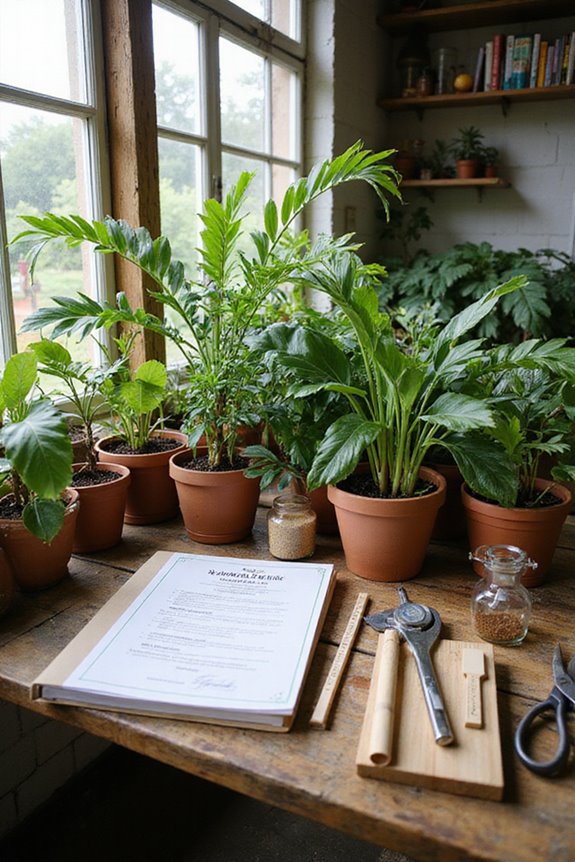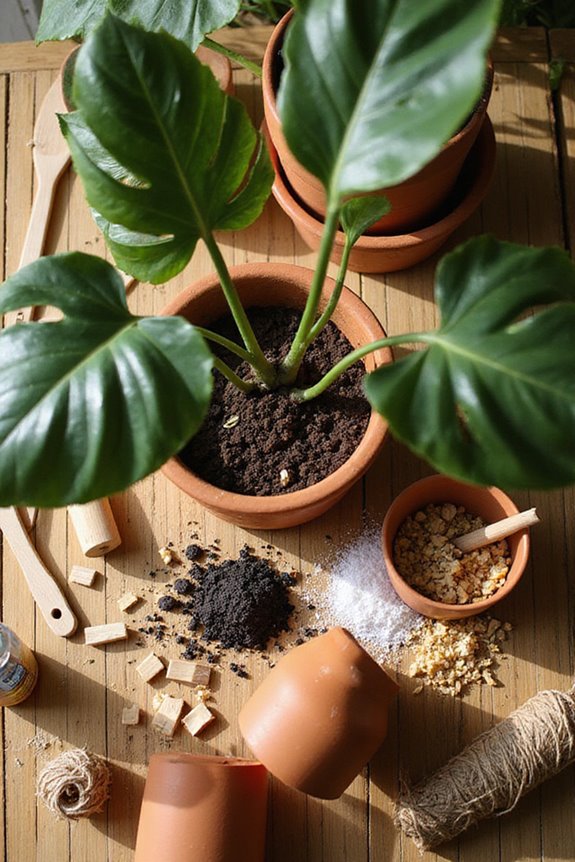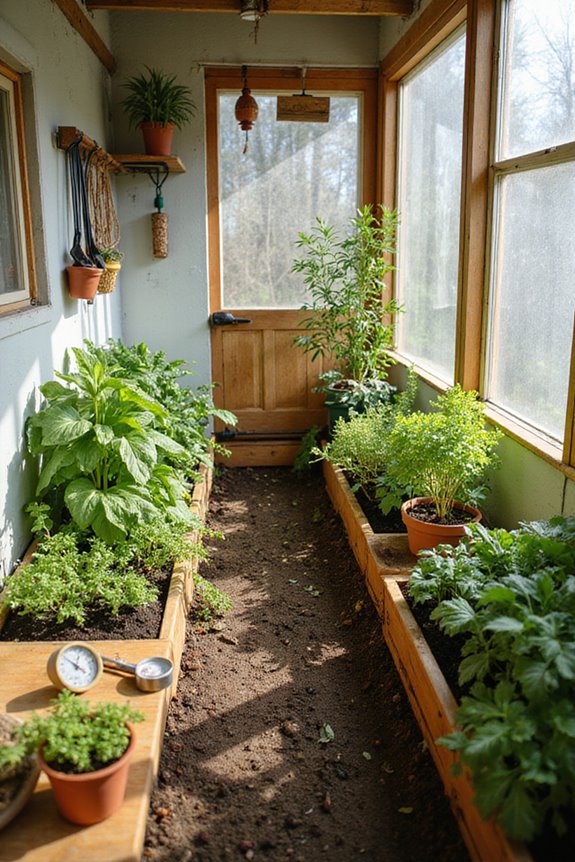To prevent root rot in pots, we can adopt a few key practices. First, we should water only when the top inch of soil feels dry. Second, using pots with drainage holes is essential to avoid excess moisture. Choosing the right soil mix, like one with perlite, helps improve drainage. Finally, keeping an eye on environmental conditions, such as airflow and temperature, supports healthy roots. If we explore further, we’ll discover more strategies to keep our plants thriving.
Key Takeaways
- Water plants only when the topsoil is dry to prevent excess moisture in the pot.
- Use pots with adequate drainage holes to promote proper water flow and prevent waterlogging.
- Choose well-balanced potting mixes with perlite or coarse sand for improved drainage.
- Opt for unglazed terracotta pots to enhance airflow and moisture absorption.
- Regularly monitor plants for signs of stress and adjust care practices as needed.
Understanding Root Rot and Its Causes
Understanding root rot and its causes is essential for any plant lover. Root rot is mainly caused by root pathogens, including fungi like *Pythium*, *Phytophthora*, and *Fusarium*. These organisms thrive in conditions with poor soil drainage and excess moisture. When we overwater our plants, we create an environment where these pathogens can flourish.
Here are some key factors to reflect on:
- Soil Drainage: Well-draining soil helps prevent standing water.
- Watering Practices: Avoid saturating the potting medium; let the topsoil dry between waterings.
- Environmental Conditions: High humidity and waterlogged soil increase root rot risk.
Signs of Root Rot to Watch For
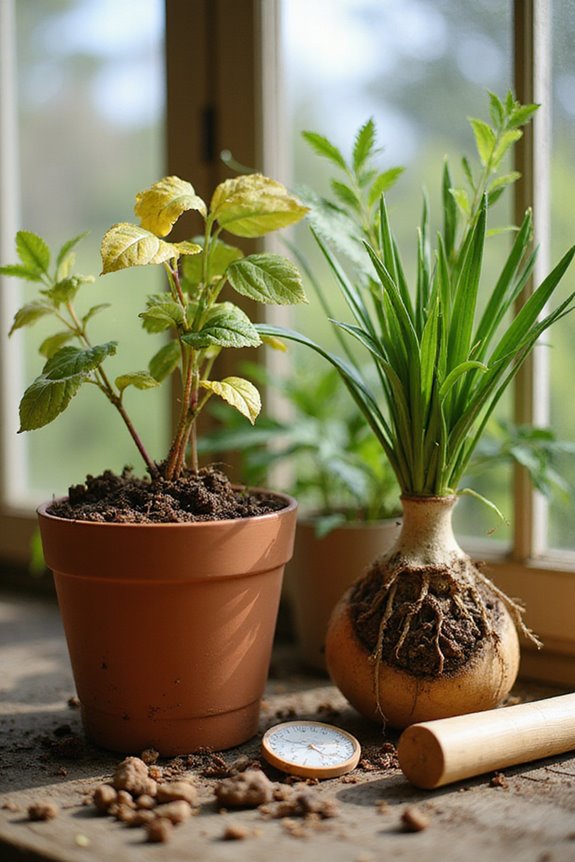
How can we tell if our plants are suffering from root rot? We should look for specific visual symptoms that indicate declining root health. First, the roots may appear dark brown or mushy instead of healthy white. If we notice leaves turning yellow or wilting, this can signal nutrient uptake issues.
Here are some key indicators to monitor:
- Roots: Dark coloration, mushy texture, or a foul smell.
- Foliage: Yellowing leaves, premature drop, or stunted growth.
- Stems: Softness and discoloration, especially near the soil line.
- Soil: Soggy conditions or a musty odor. Additionally, maintaining soil health through practices like composting can help prevent conditions that lead to root rot.
Effective Prevention Strategies
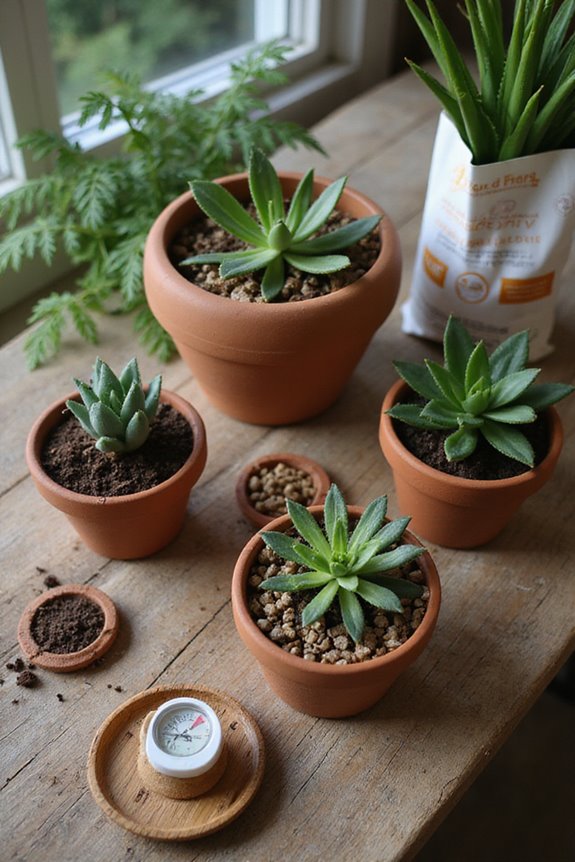
Preventing root rot is key to maintaining healthy plants. To start, we should adopt proper watering techniques. Water only when the top 1-2 inches of soil are dry, avoiding a fixed schedule. This helps us prevent overwatering. In addition, let’s choose pots wisely. Using containers with adequate drainage holes allows excess water to escape. Unglazed pots, like terracotta, can absorb moisture and improve airflow around the roots. Finally, we must monitor our plants regularly. Checking for signs of stress or disease helps us catch issues early. By implementing these strategies, we create a supportive environment for our plants, reducing the risk of root rot and ensuring they thrive in their pots. Additionally, using ergonomic tools can make tasks like repotting easier and more comfortable, promoting better plant care.
Choosing the Right Soil for Potted Plants
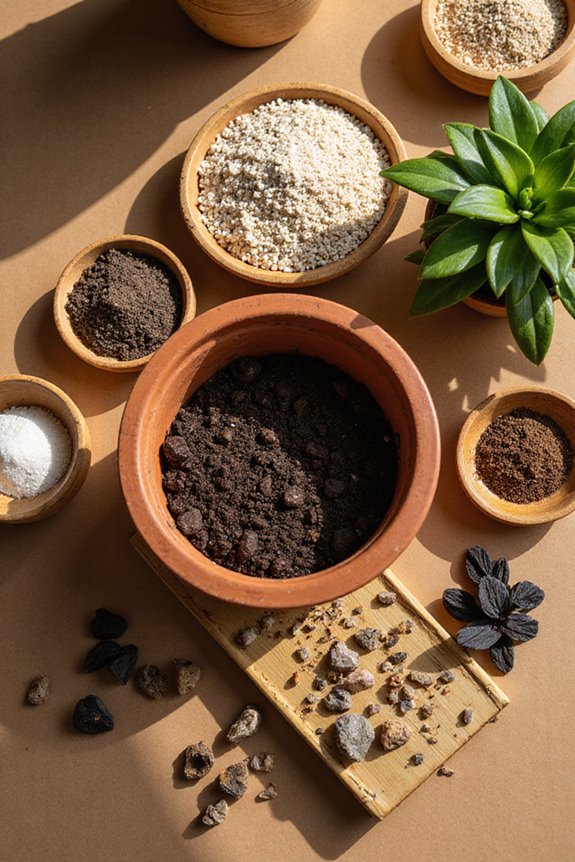
Selecting the right soil for our potted plants is essential to their health and growth. A well-balanced soil composition promotes moisture balance while preventing root rot. We should avoid heavy garden soil, which can compact and retain excess moisture. Instead, let’s choose mixes that include perlite or coarse sand for better drainage.
- For tropical plants, a mix of peat, perlite, and compost works well.
- Cacti and succulents thrive in fast-draining soils specifically designed for them.
Using fresh potting soil is vital, as old mixes may harbor pathogens. By ensuring our soil is tailored to our plants’ needs, we help create an environment where roots can thrive and stay healthy. Additionally, incorporating native plants into our gardening practices can further support soil health and promote beneficial microorganisms.
Environmental Factors That Affect Root Health
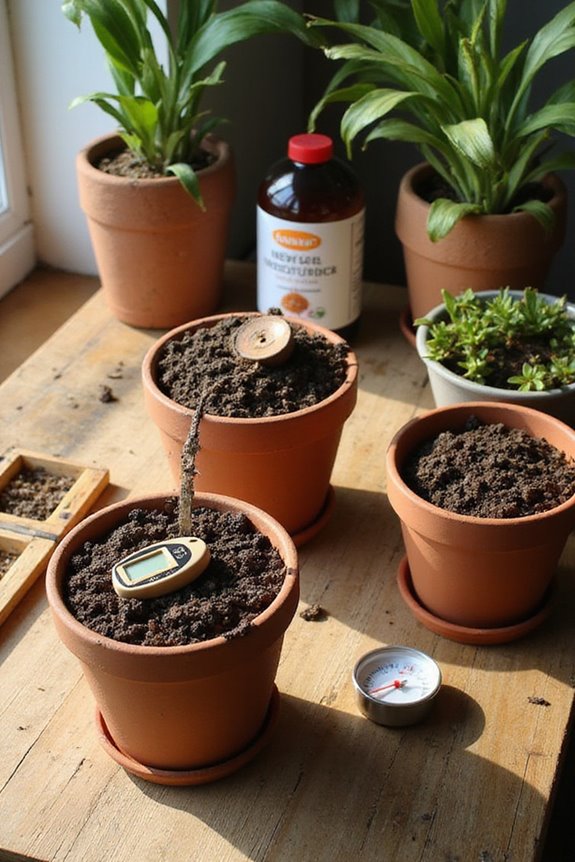
After confirming we have the right soil for our potted plants, it’s important to reflect on the environmental factors that influence root health. Here are key aspects to take into account:
- Soil Drainage: Well-draining containers help prevent waterlogging, which can suffocate roots. Verify drainage holes are clear.
- Air Circulation: Good airflow around plants keeps humidity levels in check and promotes healthy root respiration, reducing fungal risks.
- Temperature Stability: Maintain consistent temperatures suitable for your plants. Fluctuations can stress roots and increase susceptibility to rot.
- Light Exposure: Provide adequate light to support photosynthesis. Too much or too little can weaken roots.
- Pathogen Control: Use sterile soil and monitor for pests. Healthy roots are more resilient to pathogens and stress. Additionally, consider moisture management practices that can help reduce the risk of root rot and maintain optimal root health.
Treatment Options for Root Rot Damage
When we notice signs of root rot in our potted plants, taking immediate action is vital. First, we should remove the plant from its pot, wash the roots, and inspect them. Healthy roots are firm and white, while rotted roots are brown and mushy. We’ll trim away the damaged parts and prune the foliage to match the root loss.
Next, we can dip the clean roots in a fungicide solution to kill any lingering spores. After that, repot the plant in fresh, well-draining soil and a sanitized pot. It’s important to manage watering carefully, keeping the soil lightly moist but allowing it to dry between cycles. With these steps, we can support root recovery and promote healthier growth.
Frequently Asked Questions
Can Root Rot Affect All Types of Potted Plants?
It is understood it’s disheartening, but root rot can affect all potted plants, whether indoor or outdoor. Together, we can learn to recognize the signs and protect our beloved plants from this common threat.
How Often Should I Check for Root Rot?
We should check our plants weekly for root inspection, especially after watering. Monitoring moisture levels helps us catch early signs of root rot, ensuring our beloved greenery stays healthy and thriving together.
What Is the Best Drainage Method for Pots?
Like a well-tuned orchestra, proper drainage materials and thoughtful pot selection harmonize plant health. We should choose breathable pots with ample drainage holes to create an environment where our plants can thrive together, free from excess moisture.
Are There Specific Plants More Susceptible to Root Rot?
We’ve noticed certain plants, like peace lilies and boxwoods, show clear root rot symptoms. By sharing plant care tips, we can help each other keep our green friends healthy and thriving together in our homes.
Can Root Rot Be Prevented With Organic Fertilizers?
We believe organic fertilizers can considerably boost root health. They enhance soil structure and aeration, promoting healthy microbial life that helps prevent root rot. Together, we can cultivate resilient plants thriving in nutrient-rich environments.


